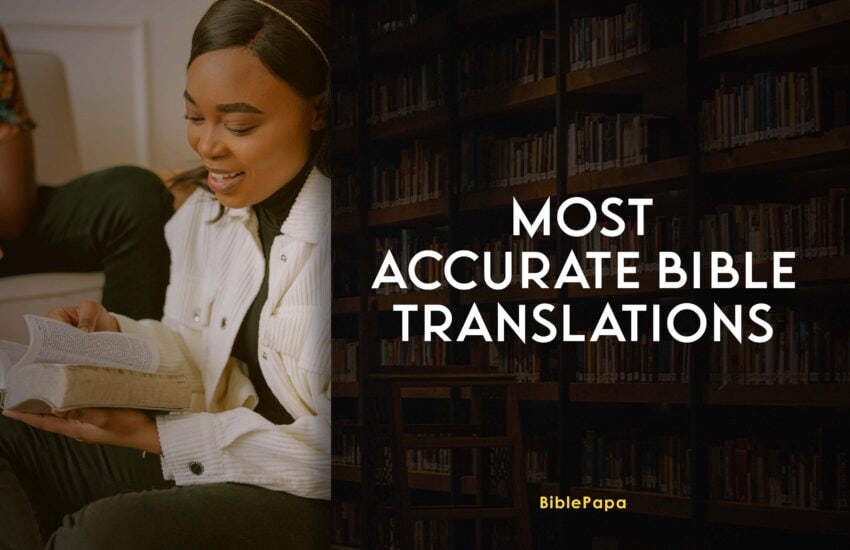In the modern world, Bible translations are important asset that is used to understand the messages of the scriptures. It has been perfectly transcribed by knowledgeable set of Individuals and are widely used in various Christian denominations.
The Bible translations present in this article, focus on giving a clear understanding and an accurate interpretation of the scriptures that have been passed down for decades.
The Significance of The Bible
The Bible is a work of literature that was written centuries pass by well-esteemed people in various languages. These languages have been studied and translated to aid an easy understanding of the scripture.
Different Bible translations have been made available to the masses which leaves us to wonder if they are correct or non-sequential. Well, It is pleasing to say that the bible translations listed in this article are remedied to be the best and most well-documented versions.
Original Language of The Bible
The Bible has a long history with roots in ancient languages and is one of the most significant and widely read religious texts in the world. It is a collection of unique novels that numerous authors from various cultural backgrounds have authored for centuries.
As a result, comprehending the background, content, and interpretations of the Bible requires knowledge of its original languages. The Bible is categorized into two testaments which are;
- The Old Testament
- The New Testament.
The first section of the Christian Bible, known as the Old Testament, is mostly written in Hebrew, the ancient Israelites’ native tongue. In this section of the book, the first man to work on the surface of the earth was chronicled along with the history of how the world came to be.
The New Testament, the second section of the Bible, was composed in Greek. It draws on narratives of Jesus Christ’s life, teachings, death, and resurrection as well as the deeds that early Christian leaders did to continue Christ’s mission on earth.
Importance of Bible Translation
Making the Holy Book available to people all across the world is the primary motivation behind Bible translation.
It promotes a stronger connection to one’s faith by enabling people to comprehend and interact with the teachings, knowledge, and spiritual direction it delivers.
Further significance:
- It encourages cross-cultural interaction and aids in the propagation of Christianity.
- It aids in maintaining the accuracy and key message of the Bible’s content through generations and linguistic barriers.
20 Most Accurate Bible Translations
Here is a list of Bible translations that have been proven to be accurate by scholars:
- New American Standard Bible (NASB)
- English Standard Version (ESV)
- New Revised Standard Version (NRSV)
- King James Version (KJV)
- New King James Version (NKJV)
- Revised Standard Version (RSV)
- Christian Standard Bible (CSB)
- New International Version (NIV)
- Holman Christian Standard Bible (HCSB)
- New Living Translation (NLT)
- New English Translation (NET Bible)
- Amplified Bible (AMP)
- Revised English Bible (REB)
- Contemporary English Version (CEV)
- New Century Version (NCV)
- New Jerusalem Bible (NJB)
- The Message (MSG)
- Jerusalem Bible (JB)
- Douay-Rheims Bible (DRB)
- Common English Bible (CEB).
Discussing the most Historically accurate Bible Translations
1. New American Standard Bible (NASB)
Published by: Lockman Foundation
Released Year: 1971.
The New American Standard Bible (NASB) is a well-known translation of the Bible that closely follows the ancient Greek, Hebrew, and Aramaic manuscripts. Although it was published decades ago, it nevertheless maintains its accuracy and is becoming easier to read. Its literal translation style, which allows for in-depth study and comprehension of the texts, is generally praised by readers.
It is one of the most precise Bible translation that has undergone additional upgrades to ensure public understanding. The NASB’s dedication to maintaining a word-for-word translation style is one of its distinguishing qualities. As a result, the English text faithfully conveys the biblical texts’ original meaning.
2. English Standard Version (ESV)
Published by: Crossway
Released Year: 2001.
The English Standard Version (ESV) is a popular modern English translation of the Bible. A group of 100 evangelical scholars and theologians collaborated to translate the Hebrew, Aramaic, and Greek biblical manuscripts into English, ensuring the highest level of scholarly rigor and correctness.
The ESV was primarily developed to strike a balance between literalness and modern language. It is widely utilized by individuals around the world and is a component of the early Bible.
The authority and inspiration of the original biblical passages are still there, despite the usage of contemporary English. It is vividly elaborated for user understanding.
3. New Revised Standard Version (NRSV)
Published by: National Council of Churches (NCC)
Release Year: 1989.
The New Revised Standard Version (NRSV) is a translation of the bible that has become well-known for making an effort to ensure an accurate interpretation of the bible’s original language.
The project started in 1937, and it was finished and published in 1989. It is among the top translations of the Bible that render the biblical passages accurate for different Christian groups.
The NRSV has undergone a major period of updating, and when appropriate, it employs contemporary and inclusive language. It was created by numerous teams of specialists with distinct Christian backgrounds, assuring a thorough translation process.
4. King James Version (KJV)
Published by: The Decree of King James I
Released Year: 1611.
The King James Version is a translation of the Bible that was made under the direction of King James I of England and distributed by numerous printers. These translations started in 1604 and finished in 1611. King James I commissioned a group of English academics and theologians to write an English translation of the Bible, and they did it.
The English translation was initially produced for use in the Church of England, but over time it has evolved to be one of the most widely used versions of the language. It is the only one that was strongly structured while keeping what the words implied when it was first penned.
Also, the translation uses formal, regal language, which has aided in its continuing appeal and cultural influence. The KJV is popular for liturgical use, public readings, and memorization due to its elegant prose and poetic flair.
5. New King James Version (NKJV)
Published by: Thomas Nelson, Inc.
Released Year: 1982.
The New King James Version (NKJV) is a modification revision of the King James Version (KJV) published by a prominent Christian company called The Thomas Nelson, Inc. Since its debut, a lot of readers in the public have bought it, which has helped the verse grow notoriety and turn into one of the most often used Bible translations.
The NKJV’s main goal was to update the KJV’s language and grammar while retaining its elegance, correctness, and literary style. The poetic and formal language of the KJV is mostly preserved in the NKJV. Modern readers admire how they kept the spirit of the KJV while employing more modern language.
6. Revised Standard Version (RSV)
Published by: The National Council of Churches (NCC)
Released Year: 1952.
The Revised Standard Version (RSV) is a widely used English translation of the Bible that came into existence through the effort of various scholars from Christian denominations who put their time into interpreting the original scriptures.
This project’s construction began in 1937, and it may have taken up to 15 years to finish. Before the rest was uploaded, the New Testament was first published in 1946.
The King James Version (KJV)’s conventional language was preserved in the RSV, but some outdated phrases and words were also used. The only goal is to provide a contemporary English translation of the Bible that can be used for scholarly, liturgical, and devotional purposes.
7. Christian Standard Bible (CSB)
Published by: Holman Bible Publishers
Released Year: 2017.
The Christian Standard Bible (CSB) is a modern English translation of the Bible and one of the earliest versions that were published. In addition to being early, it also became one of the most well-known Bible translations ever produced.
It was created with accuracy and readability in mind for a variety of audiences, including personal study, devotional reading, and church use.
The CSB uses modern terminology and idiomatic terms to aid in understanding while carefully maintaining the original writings that are being translated. This was made possible by the dedication of more than 100 evangelical academics from various faiths, who ensured a wide-ranging and multifaceted viewpoint during the translation process.
8. New International Version (NIV)
Published by: Zondervan, A Christian publishing company.
Released Year: 1978.
Another Bible translation that has gained a reputation for being the most widely used is the New International Version (NIV). It is a meticulous translation that was proposed by an international group of translators who aimed to produce a comprehensible, accurate, and readable version of the Bible for modern readers.
In order to accommodate different demands and preferences, it also passes through revised editions.
The goal of the NIV is to help readers understand. It was created thoroughly to support efficient independent study.
9. Holman Christian Standard Bible (HCSB)
Published by: Holman Bible Publishers
Release Year: 2004.
The Holman Christian Standard Bible (HCSB) is one of the earliest bible translations that is regarded as being well-detailed because of the enormous work of some evangelical scholars. It aims to provide a clear and accurate representation of the original Hebrew, Aramaic, and Greek texts while using modern language and idiomatic expressions to enhance understanding.
The HCSB was created with a diverse and all-encompassing approach to the translation process in mind. Additionally, it provides information on the most recent advances in linguistic and biblical studies.
HCSB’s translation methodology is one of its distinctive qualities. Readers value the usage of optimal equivalence, which combines aspects of formal and dynamic equivalence.
10. New Living Translation (NLT)
Published by: Tyndale House Publishers
Release Year: 1996.
Another one of the most accurate Bible translations is The New Living Translation (NLT). A team of scholars worked to generate this well-known English translation of the Bible. It is written in a way that makes the original Hebrew, Aramaic, and Greek text simple to understand while still keeping accuracy for straightforward accessibility to a variety of readers.
The dynamic equivalence translation process, used by the NLT, aims to accurately capture the overall message and intent of the biblical texts. Churches and other educational institutions frequently use it. Additionally, it is a useful tool for solitary study.
11. New English Translation (NET Bible)
Published by: Biblical Studies Press (BSP)
Released Year: between 1998 and 2005.
The New English Translation (NET Bible) is an English translation of the Bible used by individuals, scholars, and ministries worldwide. It includes a special function that makes the translation process transparent.
The detailed translators’ notes, which accompany the text and allow readers to see the reasoning behind each translation and provide more explanation, are given in great detail.
A group of academics, linguists, and Bible translators worked on the NET Bible. This multidisciplinary team of professionals worked together to translate the Bible into an accurate and understandable form while retaining the subtleties and significance of the original Hebrew, Aramaic, and Greek passages.
12. Amplified Bible (AMP)
Published by: Zondervan, a Christian publishing company
Release Year: 1965.
The Amplified Bible (AMP) is a unique type of Bible translation created by Frances Siewert whose aim is to produce a version that would enable a more complete knowledge of the original biblical texts by amplifying keywords and phrases. The content is amplified by including additional words and phrases inside the brackets to clarify its original meaning.
This method of “amplification” aims to help readers understand the variety and complexity of biblical languages by providing alternate translations, additional meanings, and explanatory material.
13. Revised English Bible (REB)
Published by: Oxford University Press and Cambridge University Press
Release Year: 1989.
The Revised English Bible (REB), one of the most accurate Bible translations, was created with the help of academics from different Christian faiths with the goal of accurately and faithfully translating ancient biblical passages into today’s vernacular. It also reminds you of the strategy of fusing formal and dynamic equivalence.
The REB has received recognition for its clarity, literary excellence, and devotion to scientific accuracy since it was first published. Many people, churches, and academic institutions have welcomed it as a helpful tool for learning and comprehending the Bible.
14. Contemporary English Version (CEV)
Published by: American Bible Society (ABS)
Released Year: 1995.
The Contemporary English Version (CEV) is a well-simplified Bible translation that helps with understandable language, making it accessible to readers of all ages, including youngsters, those with poor English skills, and others looking for a straightforward and straightforward reading experience.
The CEV efficiently communicates the biblical content by utilizing modern slang and grammatical frameworks. No matter how comfortable someone is with difficult or antiquated language, the essential goal is to make the Bible’s teachings understandable to a large audience.
The version is a popular choice for evangelism, outreach, and private devotional reading because of its “simplicity,” which is one of its distinguishing qualities
15. New Century Version (NCV)
Published by: Thomas Nelson Publishers.
Released Year: 1987
The last on the list is the ‘The New Century Version (NCV)’. This Bible translation was primarily created to aid people for whom English is a second language or those who find it difficult to understand regular translations. People of all ages and reading abilities can enjoy it because of its well-known use of simple language.
While integrating contemporary idioms and language to effectively communicate the message, the NCV emphasizes upholding authenticity to the original biblical manuscripts. To ensure readability and clarity, a small vocabulary is used.
16. New Jerusalem Bible (NJB)
Published by: Darton, Longman & Todd Ltd
Release Year: 1985
The Jerusalem Bible (JB) has been revised and is now known as the New Jerusalem Bible (NJB). Roman Catholics use it extensively, and it is praised for both its literary merit and scholarly approach.
A group of academics have laboriously examined the scripture to produce the NJB, which offers readers a lucid comprehension. To achieve a correct translation of the biblical text, the Bible version’s translators investigated a variety of old manuscripts and textual sources.
The deuterocanonical books, which are recognized by the Catholic Church but not by other Christian faiths, are included in the New Jerusalem Bible.
17. The Message(MSG)
Published by: Eugene Peterson in partnership with NavPress.
Release Year: 1993 to 2002.
The Message is said to be more of a paraphrase than a translation that uses contemporary idioms and expressions to give the Bible’s general meaning and message in a way that is understandable and modern.
The Message makes the Bible understandable to a larger audience, particularly for people who might find it difficult to comprehend traditional translations. It is not usually suggested for theological clarity or in-depth study, but it is valuable for its readability and novel presentation.
It is noteworthy that the selection of a translation is frequently contingent upon personal inclinations, educational objectives, and the intended application of the Bible.
18. Jerusalem Bible (JB)
Published by: Darton, Longman & Todd Ltd, a British publishing house.
Release Year: 1966.
In general, especially when considering the Roman Catholic tradition, the Jerusalem Bible (JB) is a reliable and accurate translation of the Bible. With an emphasis on literary excellence and readability for modern audiences, it seeks to create a modern English translation of the Bible.
Additionally, the Jerusalem Bible is acknowledged for its contributions to biblical scholarship especially in the context of the Roman Catholic tradition. Translated by a group of academics led by Roman Catholic priest and biblical scholar Alexander Jones.
19. Douay-Rheims Bible (DRB)
Published by: National Council of Churches (NCC)
Release Year: 1609–1610.
The English translation of the Bible known as the Douay-Rheims Bible (DRB) was mostly translated by Catholics. First published in 1582 was the New Testament; the entire Bible, including the Old Testament, was released in 1609–1610.
The translation effort was undertaken in reaction to the Protestant Reformation with the goal of producing an English translation consistent with Catholic teaching.
Given the Catholic origins of the Douay-Rheims Bible (DRB), great effort was taken by the translators to accurately represent the doctrinal intricacies that are central to the Catholic faith.
20. Common English Bible (CEB)
Published by: Abingdon Press
Release Year: 2011.
The Common English Bible (CEB) is widely regarded as accurate in the sense that it attempts to accurately portray the original languages in a way that is comprehensible to readers of today.
Scholars from several Christian traditions contributed to the production of the CEB, as it was an ecumenical translation. A broad spectrum of Christian denominations were to accept this translation, according to the plan. An inclusive and approachable translation was made possible by the involvement of academics from different backgrounds.
What is the Most Accurate Bible Translation from the Original Text?
The most accurate Bible version from the original manuscripts is a matter of opinion that might differ depending on personal viewpoints and theological inclinations.
These translations presence in this article are renowned for their intellectual rigor and dedication to correctness. However, the five most accurate and globally preferred versions are:
- Bible New American Standard (NASB)
- Version English Standard (ESV)
- New Revised Standard Version (NRSV)
- Revised Standard Version (RSV)
- Version King James (KJV).
It is crucial to consider your personal needs and preferences when choosing a Bible translation. Some individuals prioritize modern language and readability over literal, formal translations, while others prioritize the opposite. Additionally, a more comprehensive understanding may be gained by examining and comparing several translations.
FAQs on the Most Accurate Bible Translations
Where can I get these Bible versions?
The Bible translations are made freely accessible online and can be purchased offline in hardcopy format.
Are these Bible translations Available offline?
Yes, they are made available for purchase offline. Visit any bookstore around your vicinity; they will guide you on how to get your copy.
Are they Bible translations that are not written in English?
Yes, there are other Bible translations that are not written in English that aid to assist the reader. The Bible has been interpreted into various languages to enable better understanding for people around the world.
Conclusion
To reach a wide range of people, the Bible has been translated into many different languages. Scholars, scribes, and translators have worked diligently for generations to transmit the Bible’s original languages and subsequent versions. These versions have been produced to help readers understand the scriptures.
The Bible has life-taught lessons that can help you with certain decisions you make. It can serve as a personal guide and advisor. Getting the right Bible translations will not only make it easy to read but to understand the message that has been passed on for centuries.
They are sequential and renowned for giving a well-detailed meaning to the ancient written records.






